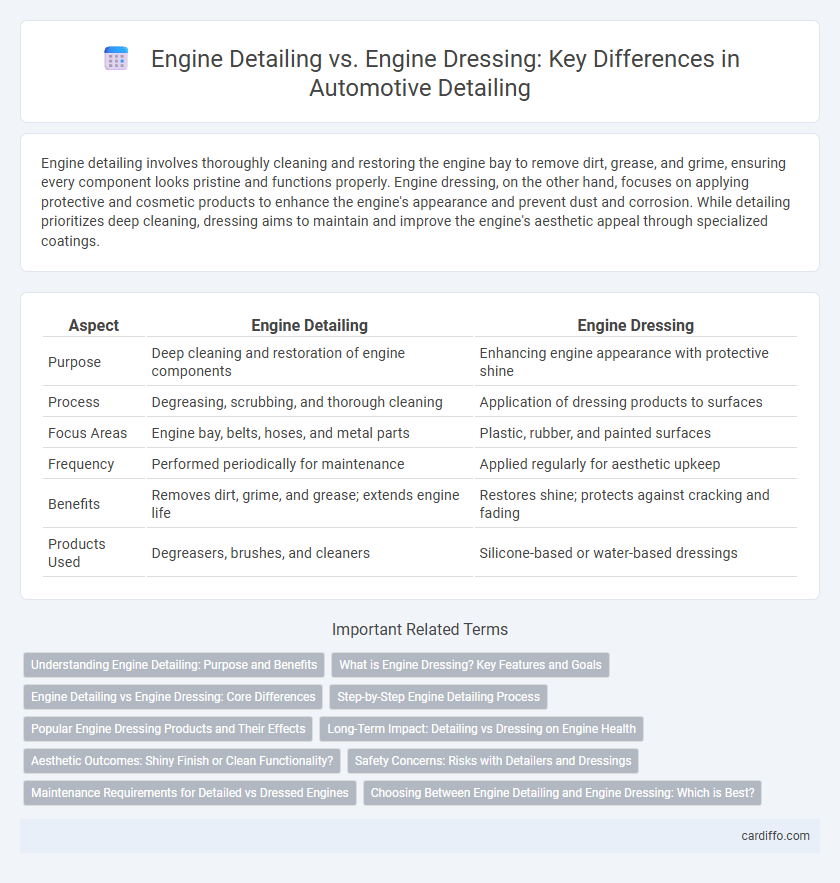Engine detailing involves thoroughly cleaning and restoring the engine bay to remove dirt, grease, and grime, ensuring every component looks pristine and functions properly. Engine dressing, on the other hand, focuses on applying protective and cosmetic products to enhance the engine's appearance and prevent dust and corrosion. While detailing prioritizes deep cleaning, dressing aims to maintain and improve the engine's aesthetic appeal through specialized coatings.
Table of Comparison
| Aspect | Engine Detailing | Engine Dressing |
|---|---|---|
| Purpose | Deep cleaning and restoration of engine components | Enhancing engine appearance with protective shine |
| Process | Degreasing, scrubbing, and thorough cleaning | Application of dressing products to surfaces |
| Focus Areas | Engine bay, belts, hoses, and metal parts | Plastic, rubber, and painted surfaces |
| Frequency | Performed periodically for maintenance | Applied regularly for aesthetic upkeep |
| Benefits | Removes dirt, grime, and grease; extends engine life | Restores shine; protects against cracking and fading |
| Products Used | Degreasers, brushes, and cleaners | Silicone-based or water-based dressings |
Understanding Engine Detailing: Purpose and Benefits
Engine detailing involves deep cleaning and degreasing the engine bay to remove dirt, oil, and grime, enhancing both appearance and functionality. This process prevents corrosion, improves heat dissipation, and helps identify potential leaks or mechanical issues early. Unlike engine dressing, which primarily enhances aesthetic shine, engine detailing focuses on maintaining engine health and performance.
What is Engine Dressing? Key Features and Goals
Engine dressing involves applying specialized coatings or sprays to engine components to enhance appearance, provide protection, and maintain cleanliness. Key features include water resistance, heat tolerance, and the ability to prevent dust and grime buildup, ensuring a long-lasting glossy finish. The primary goal is to improve the engine bay's aesthetic appeal while protecting surfaces from corrosion and wear.
Engine Detailing vs Engine Dressing: Core Differences
Engine Detailing involves thorough cleaning of all engine components, removing dirt, grease, and grime to restore the engine's original appearance and functionality. Engine Dressing, on the other hand, focuses on applying protective coatings or shine-enhancing products to improve the engine's aesthetic appeal and prevent dust accumulation without deep cleaning. The core difference lies in engine detailing's emphasis on cleanliness and maintenance versus engine dressing's focus on surface protection and visual enhancement.
Step-by-Step Engine Detailing Process
Engine detailing involves a thorough cleaning process including degreasing, scrubbing with brushes, and rinsing to remove dirt, grease, and grime from engine components. After drying, protectants are applied to prevent corrosion and enhance the engine's appearance, ensuring each part remains functional and looks pristine. This step-by-step method contrasts with engine dressing, which primarily focuses on applying a finishing product to improve shine without deep cleaning.
Popular Engine Dressing Products and Their Effects
Popular engine dressing products such as Chemical Guys Rubber Shine, Meguiar's Endurance Tire Gel, and Griot's Garage Tire Gel create a high-gloss, wet-look finish on engine components while offering protection against cracking and fading. These products differ from engine detailing, which involves deep cleaning and degreasing to remove oil, dirt, and grime buildup for optimal engine performance and longevity. Using engine dressing alone can mask dirt and residue, whereas thorough engine detailing ensures both cleanliness and a pristine appearance.
Long-Term Impact: Detailing vs Dressing on Engine Health
Engine detailing involves thorough cleaning and removal of grime, oil, and dirt buildup, which helps prevent corrosion and maintains optimal engine performance over time. Engine dressing applies a protective coating to enhance appearance and repel dust, but it does not address underlying engine contaminants that can degrade components in the long run. Regular engine detailing promotes sustained engine health by ensuring cleanliness and reducing wear, whereas dressing mainly preserves aesthetics without significantly impacting engine longevity.
Aesthetic Outcomes: Shiny Finish or Clean Functionality?
Engine detailing focuses on thorough cleaning to remove dirt, grease, and grime, resulting in a visibly clean and well-maintained engine bay that emphasizes clean functionality. Engine dressing applies specialized products to create a shiny, polished finish that enhances the aesthetic appeal but may not address deep cleaning or mechanical performance. Choosing between engine detailing and dressing depends on whether the priority is a spotless, functional engine or a glossy, visually striking appearance.
Safety Concerns: Risks with Detailers and Dressings
Engine detailing involves thorough cleaning using specialized solvents and brushes to remove grease and grime, posing risks if harsh chemicals contact sensitive engine components or electrical systems. Engine dressing applies protective, silicone-based products to enhance appearance but can cause slippery residues leading to belt slippage or attract dirt that compromises engine performance. Proper ventilation, protective gloves, and careful application prevent chemical exposure and mechanical failures during both detailing and dressing processes.
Maintenance Requirements for Detailed vs Dressed Engines
Engine detailing involves deep cleaning and degreasing to remove all dirt, grime, and oil residues, requiring thorough maintenance to preserve the engine's pristine condition and prevent buildup. Engine dressing applies protective coatings and silicone-based products to enhance appearance and provide a glossy finish, demanding regular reapplication to maintain the shine and protect against cracking or fading. Detailed engines require careful upkeep to avoid contamination, while dressed engines need consistent touch-ups to retain the dressing's effectiveness and longevity.
Choosing Between Engine Detailing and Engine Dressing: Which is Best?
Engine detailing involves deep cleaning and restoring the engine bay to a like-new condition by removing dirt, grease, and grime, while engine dressing focuses on applying protective and aesthetic coatings to enhance the engine's appearance. Choosing between engine detailing and engine dressing depends on the desired outcome: thorough cleanliness and maintenance versus a polished, showroom-ready look. For optimal engine care, incorporating engine cleaning before applying a high-quality dressing ensures both preservation and visual appeal.
Engine Detailing vs Engine Dressing Infographic

 cardiffo.com
cardiffo.com